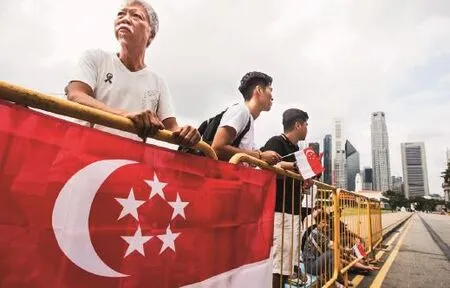Singapore’s Important Role
By Zhang Ming
Singapore’s Important Role
By Zhang Ming
Singapore is recognized as the “crossroads of the Orient” due to its position in the Malacca Straits. As one of the major economies in ASEAN, it acts as a world-leading financial center, as well as a crucial center of services and shipping in Asia. Singapore is playing an even more important role now in building the 21st-Century Maritime Silk Road furthering China's Ming Dynasty official Zheng He's Voyage to the Western Oceans in the early 15th century.
Singapore can be the springboard for China and ASEAN members to cooperate in an advantageous capacity,providing broad space for cooperation in thirdparty development.
Diversifed Economic Advantages
People often compare Singapore with Hong Kong, as they are both financial centers with much in common. However,Singapore has been developing in a more diversifed way than Hong Kong.
First, Singapore ensures homes afordable for all. Tanks to the Home Ownership Scheme, an overwhelming majority of residents have their own living space, a situation better than the “cage homes” in Hong Kong. In a broader sense, in terms of fairness of income distribution, the Gini Coefcient in Singapore is remarkably less than that in Hong Kong.
Second, Hong Kong mainly relies on the service sector, while Singapore is more competitive in the manufacturing industry,such as pharmaceuticals and petrochemicals.
Third, the financial sector in Hong Kong lives largely on the activities of its stock market, while that in Singapore develops in a more balanced way. A case in point is that Singapore operates the biggest commodity market in Southeast Asia.
Fourth, with the opening of Chinese mainland's capital account, Hong Kong is challenged by Shanghai and Shenzhen. Singapore is the financial center of the 10 ASEAN Member States with great growth potential, and it's hard to see it being replaced in the future.
Fifth, Hong Kong and Singapore have both established big RMB offshore markets. Yet, despite its larger scale, it is hard to consider Hong Kong as an “offshore market” in a real sense; meanwhile, the market in Singapore performs in a more independent way.
In addition, the State-owned Enterprises(SOEs) in Singapore also work well. They include the GIC Private Limited,the world-leading SWF; Temasek, the world-renowned financial group owned by the Government of Singapore; the Development Bank of Singapore (DBS)and the Singapore Airlines. The SOEs in Singapore have developed so distinctively that the “Temasek model” is regarded as an important example for China to follow in reforming its own SOEs.

Although Singapore is not a big country in terms of size, it plays an important role in the ASEAN.

Scenery in Singapore.
New Ideas of Singapore
In research on the 21st- Century Maritime Silk Road, I visited many academic communities and fnancial agencies,like the East Asian Institute of the National University of Singapore and GIC, to receive many opinions and much good advice:
First and foremost, the nature and the scope of the Belt and Road Initiative should be further clarified. Scholars and financial professionals in Singapore suggest the Belt and Road Initiative should focus more on the economic field, which should be defined as business, finance, infrastructure and third-party development. Tis will help countries along the Belt and Road to have a better understanding of China's intentions and dispel various doubts. At this time,regular evaluation should be carried out to promote its implementation.
Second, the action plan of the Initiative is crucial. It should at least include specifc regions, key projects and concrete departments handling implementation to prevent a blurred understanding by countries along the Belt and Road. Before unveiling the project list, exchanges and communication should be fully carried on with countries along the Belt and Road. Under the Initiative, the main body of the action should be specified so as to play an active role in cooperating with enterprises internationally in the surest way.
In addition, the action plan of the Initiative should help China and countries along the Belt and Road to communicate with and reinforce each other in terms of development strategies. A case in point is the “two corridors and one circle”, the cooperation with Vietnam. ASEAN members,including Singapore, have no idea about the relationship between the Belt and Road Initiative and the Regional Comprehensive Economic Partnership (RCEP), which should complement each other. At present,the Chinese Government still attaches great importance to RCEP cooperation.
Third, in building the 21st-Century Maritime Silk Road, Singapore can play its pivotal role in an all-round way. It should strengthen two-way connections,sound competitiveness and complementary cooperation for mutual benefit. In concrete operational fields, Singapore has shown great interest in cooperation with China in terms of finance, shipping and third-party development. As the second largest offshore RMB settlement center, it really hopes to build a large ofshore RMB market with strong liquidity. Singapore can be the springboard for China and ASEAN members to cooperate in an advantageous capacity, providing broad space for cooperation in third-party development.
Fourth, some people in Singapore point out that, at present, the implementation of the Belt and Road Initiative focuses on transnational investment in infrastructure. China does a good job in infrastructure construction. Such projects as airports,HSR, harbors or expressways, feature big investment, long payback period and low investment yield. That's exactly why countries along the Belt and Road lack investment in infrastructure. Without careful project selection and design, private capital will have no interest in investing.
China and ASEAN have labeled the past partnership a “golden decade”, and now embarked on deeper cooperation of the “diamond decade”. In 2016, Singapore,taking the ASEAN chair, will do more to promote the regional cooperation between China and ASEAN.

About the author:
The author is Director of the Department of International Investment, Institute of World Economics and Politics, Chinese Academy of Social Sciences.

